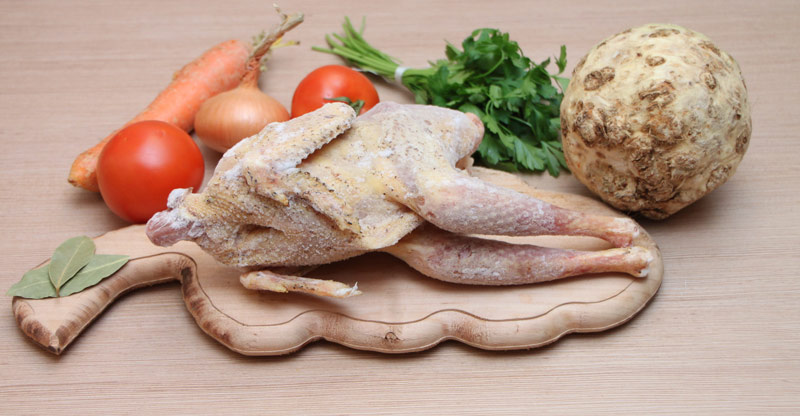Frozen food is a convenient way to preserve food and safely for the busy.
If you’re one of those people who like easy weekday cooking, you likely have a ready stock of cooked, store bought and raw foods in the freezer.
As you rummage the freezer for meat to thaw for next day’s dinner, you notice the unlabeled container.
At the sight of ice crystals covering the meat, you suddenly remember some vague rule about frozen foods.
That meat with signs of freezer burn has gone bad and should be discarded.
But the beef briskets look good for most part. You’re left wondering whether the advice is correct or just another of those food myths?
Are you wondering what ice crystals on meat signify?
Ice crystals form when the moisture or water in your food (including raw and cooked) interacts with the air in the freezer.

Beef briskets covered with ice crystals
How Does Ice Crystals Form On Meat?
When you freeze food, the water molecules in it react with the surrounding air. As this air cools, these water molecules leave your food and move towards the colder parts of the freezer, usually the sides.
They usually end up on the top of the packed meat with no where else to go. As a result, the meat surface gets coated with layer of ice. While liquid food may only develop crystals, cut vegetables or meat pieces could turn into solid blocks.
Foods like meat, fish and fruits could also end up with a freezer burn, especially when you’ve stored them for a long time.
Your food will also defrost in the freezer (due to warm air) before refreezing. The oxygen in this warmed air seeps in your food that has just lost moisture, dehydrating it further. And you end up with frosted meat that is dry, leathery and often discolored.
Related: How To Reheat a Casserole Without Drying it Out
What Causes Ice Crystals and Freeze Burn?
There are few reasons why your food loses moisture and gets coated with a layer of ice.
Before that, let’s us look at what the types of ice crystals and what they mean.
- Small ice crystals found on your meat indicates a loss of moisture in your food.
- Large ice crystals on the other hand mean that your meat has been thawing and freezing back for a while, and is likely to spoil.
Temperature Changes In Freezer
Frozen food remains their best at a steady temperatures below 0°F. Any change in temperature or fluctuations can cause the air in the freezer to warm up. This sucks away the moisture from your meat to form ice crystals.
Long Storage Time In Freezer
Sometimes we freeze foods for a short while and plan to use it soon. But somehow that frozen chicken leg gets buried under freshly frozen foods and forgotten.
Frost or ice crystals are an indication that the food has been in the frozen state for far too long.
Improper Packing Of Food
Improper packing of food before freezing can cause your meat to lose moisture and develop crystals. Beyond this, it may exhibit signs of freezer burn due to exposure to oxygen in the air.
Sometimes the plastic bag may develop a hole or leak allowing moisture to escape and air to enter.
Frequent Opening Of Freezer
Every time you open the freezer door, you allow warm air to enter and circulate inside. The abrupt changes in temperature make foods thaw although they do freeze back. This can cause ice on frozen meat as well as drying of the meat (freezer burn).
Cooked Foods Frozen While Warm
When you seal and freeze a freshly baked dish or leftovers without cooling it first, you encourage steam and condensation to form. This in turn will cause ice crystals and freezer burn.
You may also like: How To Reheat Steak In An Air Fryer [How-to and FAQ]
Is Frozen Meat With Ice Crystals Safe To Consume?
One look at the white or brown bits of meat and you have half a mind to chuck out the entire thing.
Meat with ice crystals and freezer burn is safe to eat. It won’t cause food-borne illnesses unless the meat is spoiled.
Of course, due to the dehydration process, the skin may become leathery or lose a bit of flavor. With those white, grey or brown patches your meat may be enticing, but you can cook it in anyway.
Simply scrape of the ice and cut off the dulled or darkened part. Given the leathery texture, I would advise against roasting, boiling or cooking the meat in the microwave.
If the freezer burn is extensive and the piece of meat is small and old, feel free to toss it out.
Related: Can You Leave Cooked Chicken In The Fridge For 7 Days?

Frozen salmon covered with ice crystals
Can I Prevent Ice Crystals In Stored meat?
You’ve seen the various reasons why your seafood or poultry get enveloped in a layer of ice and dry out. This is easily preventable by avoiding the mistakes we discussed in the previous section.
- Ensure your freezer settings are st optimal temperatures of 0°F or below, but not too cold. With this, your frozen food chills at a constant rate.
- Don’t open the freezer frequently or keep it open for a long time. This prevents the freezer air from warming up and thawing your meat or fish.
- Keep foods well wrapped and tightly sealed to minimize moisture loss (as ice crystals) and subsequent drying. Use double wrapping or vacuum sealing to prevent meats from softening, thawing or getting discolored.
- Keep the food frozen by placing them in the coldest part of the freezer. This is usually the bottom or the back, away from the door.
- Label the meat you plan to freeze and keep the old containers over or in front of the new ones. The longer you store meat, the more likely it will develop large ice crystals and harden up. Use the meat within 2-12 months of freezing to retain the quality.
- Don’t over crowd the freezer as cold air needs space to circulate. Stuffing your freezer could also warm up the air inside.
- Check for worn-out or broken gasket (seal) covering the freezer door. Replace damaged ones as this could allow warm air to enter your freezer and defrost foods.
- Bring foods to room temperature before you freeze them to avoid condensation and resulting ice crystals. Also store meat in smaller but properly sealed packages.
Final Thoughts
Frozen food are convenience foods that help you make easy and fresh meals at home.
The freezer is the ideal place to store meats for longer, but sometimes you’ll find ice crystals on it along with some withering. This is mostly due to faulty temperature settings, storing foods beyond the best-by date, and not packing your meat properly.
Some amount of ice is to be expected during long term storage, but you can avoid freezer burn and limit this by following the instructions I’ve provided in this guide.
You can safely consume food with ice crystals and freezer burn although you may notice some loss of flavor and texture.
Frequently Asked Questions
How to ensure store bought frozen meat is ice crystal free?
Check the package by giving it a squeeze. The content shouldn’t be a solid block. This indicates it was thawed and refrozen and could be covered in ice.
When you’re purchase these foods from the store, transport them back home in a cooler full of ice or gel packs.
Does meat keep indefinitely in the freezer?
Yes, you can keep foods in the freezer for a long time provided they are stored at the right temperature and haven’t softened yet.
The longer they sit in the freezer, the more likely they are to lose the quality, flavor and texture.
Don’t store food for more than a year, preferably 2-8 months, depending on the type of meat or seafood.

